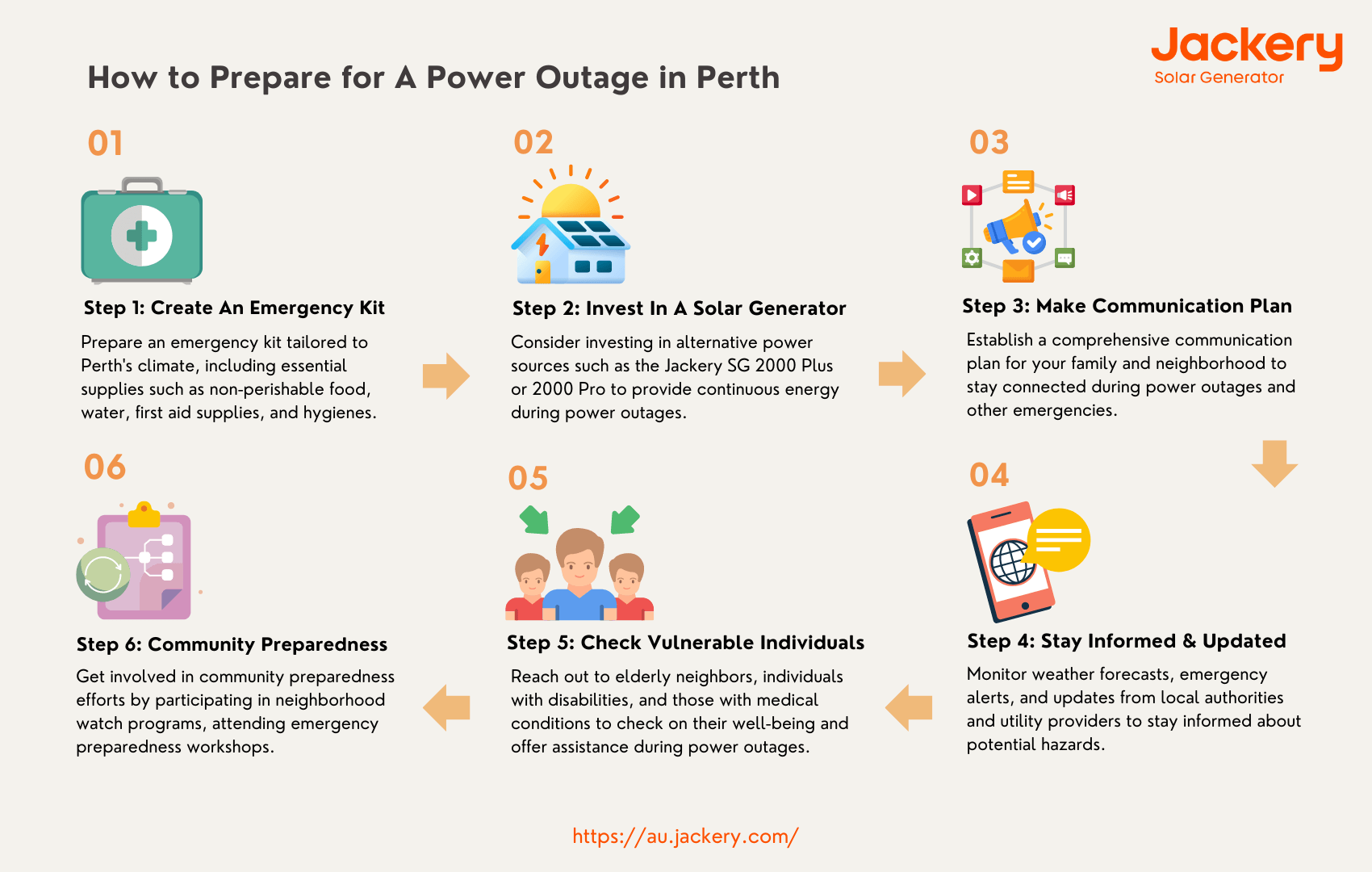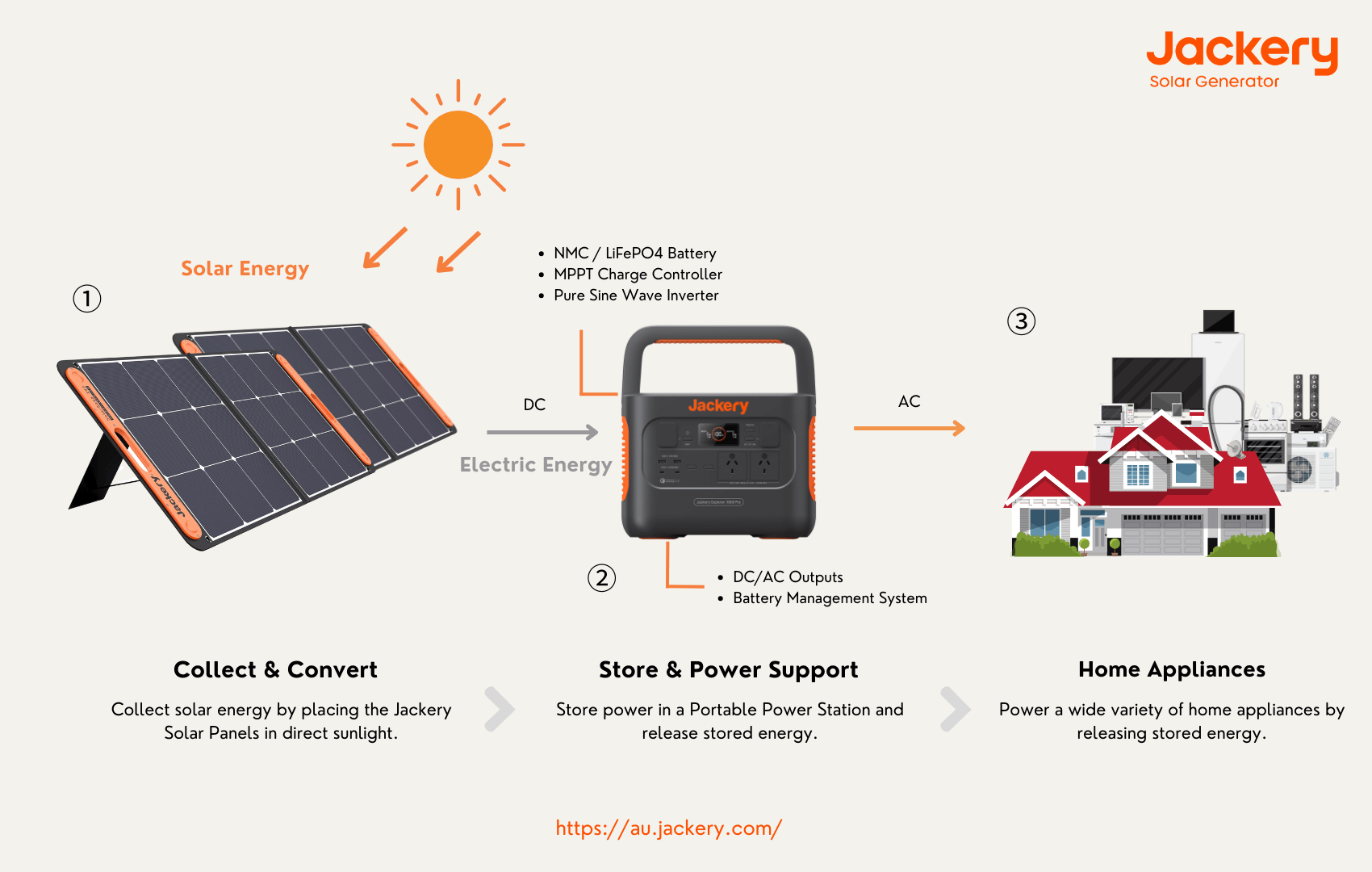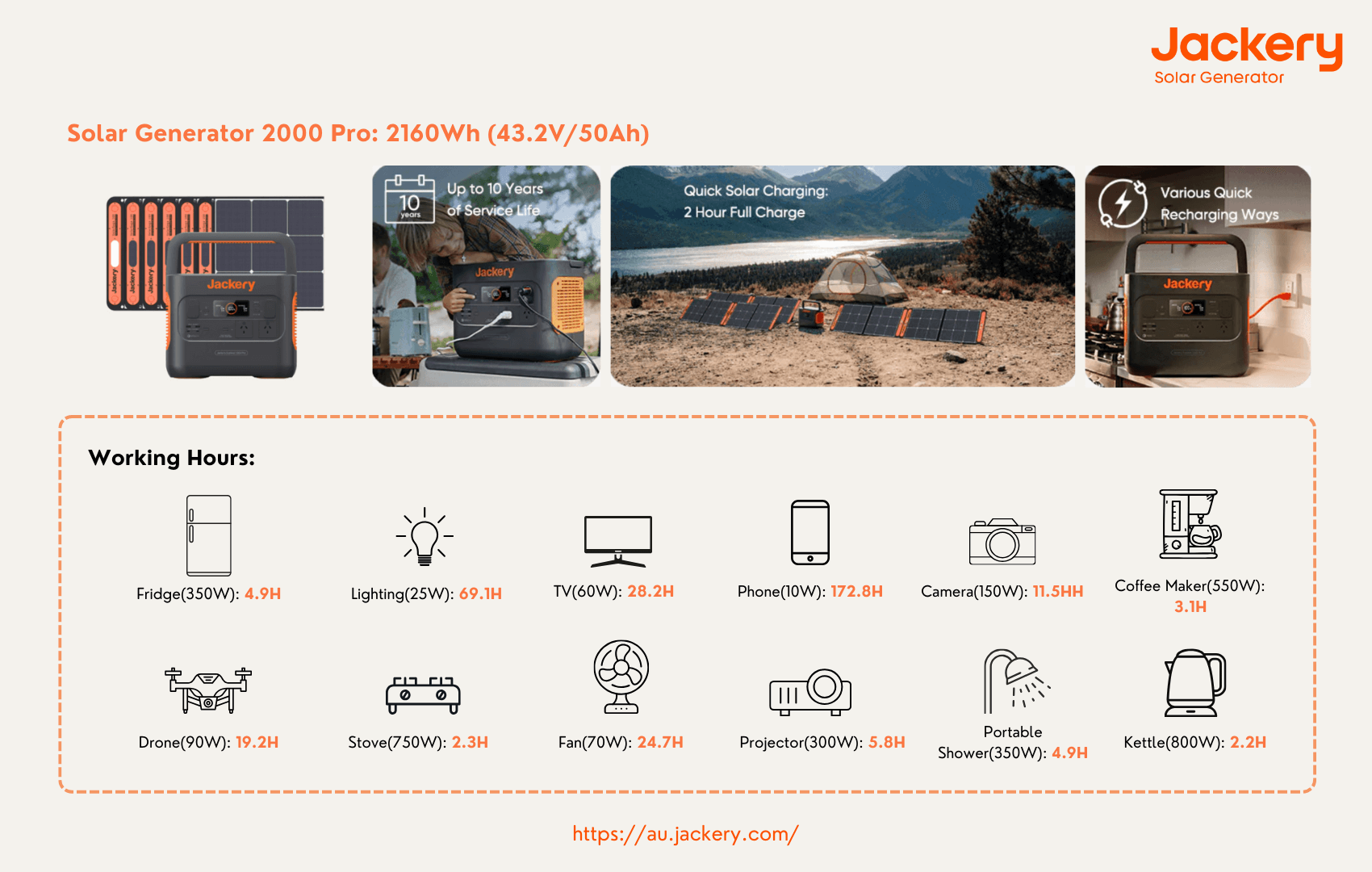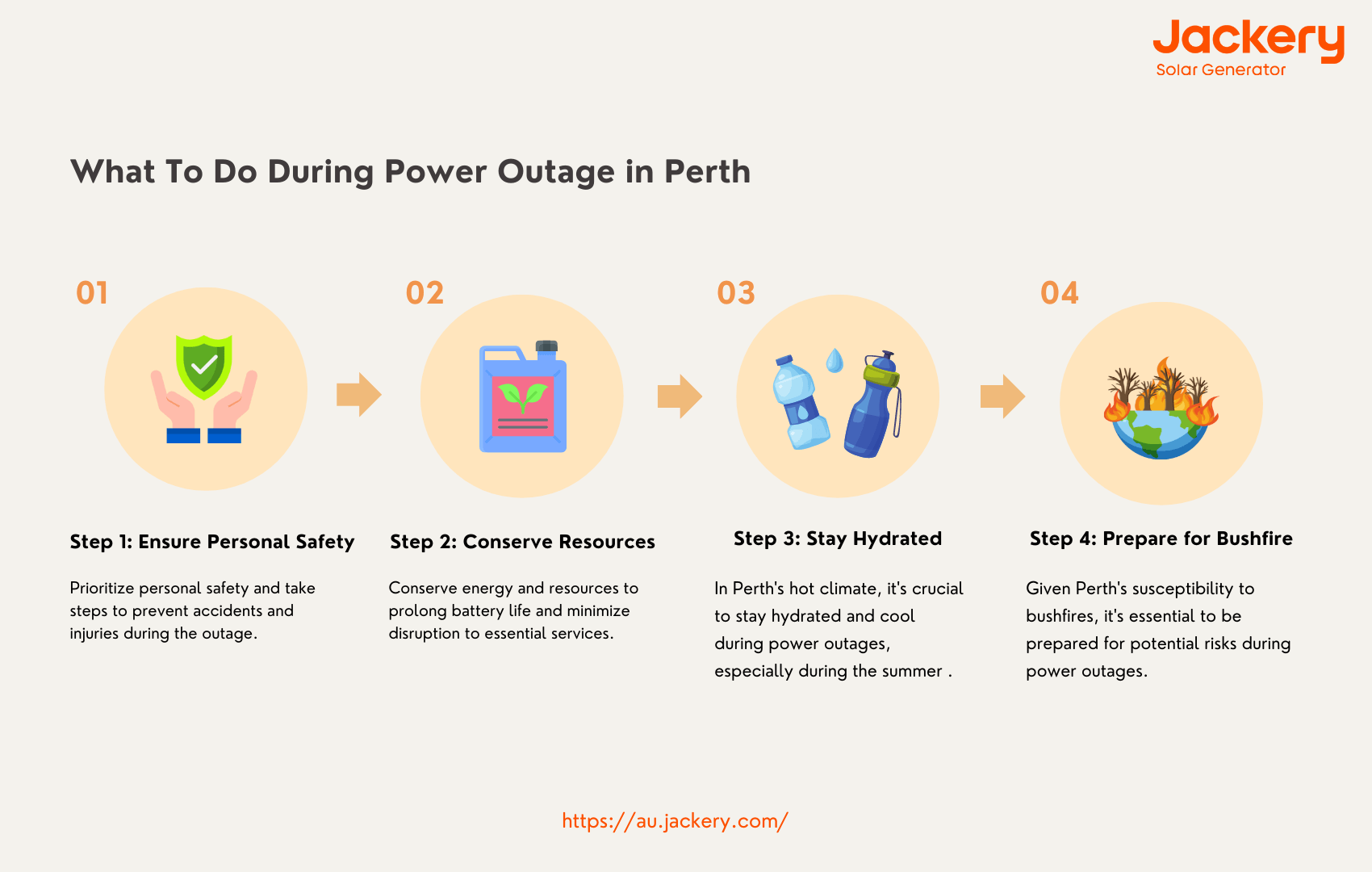|
Key Takeaways: |
|
• Various circumstances, including local weather, technology issues, and infrastructure risks, cause power outages in Perth. • Perth inhabitants frequently encounter blackouts, brownouts, and power changes. So, it is essential to prepare for a power outage in Perth. Firstly, you should create an emergency kit, invest in a solar generator, make a communication plan, stay informed, check vulnerable individuals, and join community preparedness. • Jackery Solar Generators are a safe and practical choice for power outage backup solutions. We highly recommend Jackery Solar Generator 2000 Pro and 2000 Plus to charge your essential electronics during a power outage. • During a power outage, you must have relative actions to deal with, such as ensuring personal safety, conserving energy & resources, staying hydrated, and preparing for bushfire in Perth. |
Understanding Power Outages in Perth
Various circumstances, including local weather, technology issues, and infrastructure risks, cause power outages in Perth. The following are extensive explanations for why power outages occurred in Perth.
- Weather Conditions:Perth's Mediterranean climate features hot, dry summers and warm, wet winters. Extreme heatwaves and bushfires during the summer can pose substantial dangers to the electricity grid, resulting in equipment failures, transmission line damage, and service outages. Severe thunderstorms with high winds and lightning strikes are also prevalent in Perth, resulting in downed power lines, transformer failures, and power outages.
- Technology Challenges: Technology challenges may contribute to the Perth power outage, including equipment breakdowns, software errors, and cyber threats. Ageing infrastructure, insufficient investment in grid modernisation, and poor maintenance can compound these issues, making the electricity system more vulnerable to breakdowns and outages.
- Population Growth: Perth's rapid population development and urban expansion strain the electrical grid and pose a danger of service outages.
- Seasonal Patterns: Seasonal trends are a significant factor in power outages in Perth. High temperatures and increased air conditioning usage throughout the summer can strain the electricity system, resulting in peak demand and the possibility of equipment failure. Bushfire season raises the possibility of damage to electrical infrastructure and safety shutdowns.
Exploring historical data on outage duration in various locations of Perth might provide information about the frequency and severity of power outages. Outage data analysis allows utility providers and government agencies to identify areas for improvement, prioritise infrastructure upgrades, and put measures in place to increase grid reliability and resilience. Furthermore, when there is a power outage in Perth, you may invest in a Jackery Solar Generator to ensure a consistent power supply for your home and successfully charge most of your household appliances with solar energy.
How to Prepare for A Power Outage in Perth?
Perth inhabitants frequently encounter blackouts, brownouts, and power changes. Blackouts happen when electrical power is lost, commonly caused by equipment failures, extreme weather occurrences, or system overloads during high-demand periods. Brownouts occur when power levels drop, resulting in dimmed lights and impaired appliance operation. Here are some recommendations to help you prepare for a power outage in Perth.

Step 1: Create An Emergency Kit
Prepare an emergency kit specific to Perth's climate, including non-perishable food, water, medications, first aid supplies, and hygiene items. Consider your family's particular needs, including infants, older adults, and pets, and include products like baby formula, diapers, and pet food. Pack warm clothing, blankets, and sturdy shoes to guard against cold weather during winter outages, as well as sun protection, hats, and sunscreen for hot weather crises during the summer.
|
Emergency Supply Kit |
||
|
Face masks |
Coverings |
Non-perished food |
|
3 Gallons of water per person |
Medicines |
First aid kit |
|
Clothing |
Glasses |
Extra set of keys |
|
Car keys |
Credit cards |
Cash |
|
ID |
Flashlight |
Solar Generator |
|
Sanitation |
Important documents |
Pet food |
An emergency kit on hand guarantees that you and your family can access critical supplies during power outages and other crises. Keep your emergency kit in a location where all household members can easily reach it, and inspect and restock supplies regularly to ensure they are fresh and up to date.
Step 2: Invest In A Backup Power Supply
During power outages, save energy and resources to extend battery life and reduce disruption to critical services. Turn off and disconnect non-essential electrical devices and appliances to save energy and avoid power surges when power is restored; instead of candles, which might catch fire, use battery-powered lanterns or LED flashlights to illuminate. Reduce your use of portable heaters and air conditioners to save fuel and battery power, and prioritise vital activities like cooking, heating, and communication.
Consider investing in alternate power sources, such as the Jackery Solar Generator 2000 Plus or 2000 Pro, to ensure uninterrupted electricity during power outages. These portable solar generators use the sun's power to generate clean, renewable electricity, providing a dependable backup power source for vital gadgets and appliances. The Jackery SG series, which has several AC outlets, USB ports, and a high-capacity lithium battery, offers diverse and convenient power solutions for various emergencies.
Including a portable solar generator in your emergency preparedness strategy ensures continuous power supply for vital equipment such as communication devices, medical devices, and illumination during extended outages. Furthermore, solar generators provide a more sustainable and environmentally friendly alternative to typical fuel-powered generators, reducing reliance on fossil fuels and lowering pollutant emissions.
Step 3: Make A Communication Plan
Create a comprehensive communication strategy for your family and neighbours to stay in touch during power outages and other emergencies. Designate an out-of-area contact who can operate as a central point of communication and convey critical information to family members if local communication networks are blocked. Make a list of emergency contacts, including family members, neighbours, and local authorities, and make sure everyone knows how to contact one another in case of an evacuation or separation.
Use numerous communication methods, such as mobile phones, landline phones, text messaging, email, and social media, to stay informed with loved ones and get updates from utility companies and emergency services. Practice your communication plan with your family regularly to ensure everyone knows what to do during a power outage or other emergency. Also, update contact information as needed to keep it accurate and effective.
Step 4: Stay Informed & Updated
Stay current on potential threats, evacuation orders, and restoration operations during power outages by monitoring weather forecasts, emergency alerts, and updates from local authorities and utility companies. Sign up for emergency notifications via text messages, email alerts, or government-provided smartphone apps to receive timely information and instructions. Follow official social media platforms and websites for information on weather conditions, traffic closures, and community resources during an emergency.
Step 5: Check Vulnerable Individuals
Check-in on elderly neighbours, people with disabilities, and those with medical concerns to see how they're doing and offer assistance during power outages. If necessary, assist in obtaining vital services such as medical care, transportation, and shelter. Share information about available resources and support services, such as community centres, emergency shelters, and medical facilities, to ensure everyone's safety and comfort during an emergency.
Step 6: Involved In Community Preparedness
Participate in community preparedness initiatives by joining neighbourhood watch programmes, attending emergency preparedness training, and volunteering with local disaster response organisations. Collaborate with neighbours to share resources, assist vulnerable persons, and strengthen community resilience during emergencies. Working together as a community, Perth residents can improve their ability to respond efficiently to power outages and other emergencies, protecting the safety and well-being of everyone in the neighbourhood.
Prepare for long-term power outages by stockpiling food, water, medications, and emergency supplies to maintain yourself and your family. Consider alternative housing or shelter choices, such as staying with friends or family, finding temporary lodging in hotels or motels, or using emergency shelters supplied by local authorities. Plan for backup power solutions, such as generators or solar panels, to maintain necessary services and comfort during extended outages.
Jackery Solar Generators for Power Outages in Perth
Jackery Solar Generators offer stable and portable power choices, which could be very beneficial during a Perth power outage or other emergency. These generators employ solar energy to provide clean and sustainable electricity, allowing you to charge your essential electronics and keep crucial systems running when traditional power sources are unavailable.

Jackery Solar Generators use lithium-ion battery packs, which may be recharged using Jackery Solar Panels or another charging source. The integrated solar charging capabilities enable users to recharge the battery with solar energy, changing the generator into a self-sufficient power source for outdoor activities or emergency backup power.
Jackery Solar Generators employ lithium-ion battery packs that may be recharged with Jackery Solar Panels or another charging source. The built-in solar charging features allow users to recharge the battery using solar energy, transforming the generator into a self-sufficient power source for outdoor activities or emergency backup power.
Jackery Portable Power Stations provide various power output options, including AC outlets, DC connectors, and USB ports, for charging electronics and powering household appliances. These devices are lightweight and portable, making them ideal for emergencies, particularly the Solar Generator 2000 Pro and 2000 Plus.
|
|
Jackery Solar Generator 2000 Pro |
Jackery Solar Generator 2000 Plus |
|
Capacity |
2160Wh (43.2V/50Ah) |
2042.8Wh (13A/638.4Ah) |
|
Life Cycle |
1000 cycles to 80%+ capacity |
4000 cycles to 70%+ capacity |
|
Battery Cell |
NMC battery |
LiFePO4 battery |
|
Dimension |
30.75x26.9x38.4cm |
37.36x35.94x47.3cm |
|
Recharging Methods |
Explorer 2000 Pro + 6*SolarSaga 100W: 5.5H; AC Adapter: 2H; 12V Car Adapter: 24H |
Explorer 1000 Pro + 6*SolarSaga 100W: 6H; AC Adapter: 1.7H; 12V Car Adapter: 25H |
|
Output Ports |
2*AC Output: 230V, 2200W (peak 4400W); 2*USB-A: Quick Charge 3.0x2, 18W Max; 2*USB-C: 100W Max, (5V, 9V, 15V, 12V, 20V up to 5A); 1*Carport: 12V⎓10A |
3*AC Output: 230V~ 50Hz, 3000W Max, 6000W surge peak; 2*USB-A: Quick Charge 3.0, 18W Max; 2*USB-C: 100W Max, (5V, 9V, 15V, 12V, 20V up to 5A); 1*Carport: 12V⎓10A |
Jackery Solar Generator 2000 Pro
Jackery Solar Generator 2000 Pro has an exceptional charging capacity of 2,160Wh and can be charged in under 5.5 hours using 6*SolarSaga 100W solar panels or in only 2 hours using an AC power outlet. Tailored for camping experiences, particularly in locations like New South Wales where electrical outlets are sparse, it becomes an indispensable companion for charging equipment ranging from mini-fridges to phones and illumination.
The Jackery Explorer 2000 Pro is a dependable emergency backup power supply with a ten-year lifespan and twice-weekly use. Its durability is enhanced by heat dissipation and high-temperature protection, ensuring peak performance in various environments. The SolarSaga 100W solar panel's IP67 Waterproof Rating protects it from harsh and moist situations, making it durable and trustworthy.
With a single switch, you may experience the simplicity of endless power. The modernised input and output display displays give crystal-clear data, including low battery and fault code indicators, ensuring a smooth and informed operation. The Jackery Solar Generator 2000 Pro combines cutting-edge technology with rugged dependability, providing abundant clean energy to power your travel.

Jackery Solar Generator 2000 Plus
The Jackery Solar Generator 2000 Plus is a portable powerhouse substantially advancing off-grid living and outdoor power demands. Equipped with high capacity and power output, this generator can power a regular household for weeks or meet the needs of adventurous trips and professional endeavours. It boasts a powerful 2 kWh base capacity that can be expanded to an impressive 12 kWh with extra battery packs, making it the ideal companion for road trips, outdoor adventures, heavy-duty activities, and unexpected emergencies.
Not content with mere capacity, the Jackery Explorer 2000 Plus portable power station distinguishes itself with an extendable power capability of up to 3000 W, a 30% increase over similar products in its category. This improved power supply guarantees that practically all vital equipment runs smoothly, meeting a wide range of requirements with remarkable efficiency.
Furthermore, with a quick six-hour solar charge time using 6*SolarSaga 100W solar panels, it transforms into an independent power source, utilising solar energy to fuel its operations and freeing users from reliance on the traditional power grid. In a world increasingly reliant on portable power solutions, the Jackery Solar Generator 2000 Plus stands out as a model of innovation and dependability. Whether embarking on outdoor activities, dealing with unforeseen outages, or looking for sustainable energy options, this generator provides unrivalled performance, allowing users to embrace a life of freedom and resilience.

What Size of Solar Generator Do I Need?
To choose the right size solar generator, examine your energy usage, solar panel efficiency, battery storage capacity, and your equipment's specific requirements. Selecting the appropriate size solar generator entails balancing energy requirements, installation efficiency, mobility, and cost. Depending on their energy needs, customers can choose a Jackery Solar Generator with capacities ranging from 12 kWh to 300Wh for a portable solar system. The formula for calculating the operational hours of Jackery Solar Generator-powered appliances is as follows:
Working Hours (H) = [Jackery Solar Generator Capacity (Wh)*0.85] / Appliance's Wattage (W)
The Jackery Solar Generator 2000 Pro can run a 100-watt ceiling fan for 18.36 hours (2160Wh x 0.85/100). This computation assists in determining the hours during which appliances can function.
What To Do During A Power Outage in Perth?
During a power outage in Perth, it is critical to remain cool & safe and take proper steps to reduce the impact of the outage. Here are five steps to follow during a power outage:

Step 1: Ensure Personal Safety
Prioritise personal safety and take precautions to avoid accidents and injuries during the outage. When energy is restored, turn off and unplug all electrical appliances to minimise harm from power spikes; instead of candles, which might catch fire, use flashlights or battery-powered lanterns to illuminate. Keep doors and windows closed to keep warm in inclement weather and prevent burglars from entering your home. To avoid carbon monoxide poisoning, use other heating sources, such as gas heaters with sufficient ventilation.
Step 2: Conserve Energy & Resources
Conserve energy and resources to extend battery life and prevent disruptions to critical services. Limit your use of appliances and electronic devices to save battery power for communication and emergencies. Instead of using electric equipment, cook with gas or camping stoves. Keep the refrigerator and freezer doors as closed as possible to keep food fresh and prevent spoiling. Use a portable solar generator, such as the Jackery Solar Generator 2000 Plus or 2000 Pro, to power critical gadgets and appliances during the outage.
Step 3: Stay Hydrated
In Perth's hot environment, staying hydrated and cool during power outages is critical, especially in the summer. Drinking plenty of water and seeking shade or cool interior areas is crucial to prevent heat-related illnesses. If air conditioning is inaccessible, stay cool with handheld fans, battery-operated fans, or wet towels. To avoid the heat and humidity, seek cover in air-conditioned public venues such as shopping malls, libraries, or community centres.
Step 4: Prepare for Bushfire Risks
Given Perth's vulnerability to bushfires, it's critical to be prepared for potential hazards during power outages, especially in places near bushland or rural areas. Stay informed about local authorities' blaze alarms and evacuation orders, and prepare a bushfire survival strategy. Clear vegetation and debris from your property, keep gutters free of leaves and debris and keep firefighting equipment like hoses, buckets, and fire extinguishers on hand. If a bushfire starts during a power outage, follow the evacuation instructions and seek refuge in designated evacuation centres or other safe spots.
Power Outage in Perth FAQs
The following are the frequently asked questions about the power outages in Perth:
- 1. How can I check if there's a power cut in my area?
There are several ways to check the power cut in your area:
- To check for power outages in your region, visit Western Power's website and use their outage map or reporting tool.
- Check your utility provider's social media channels for outage updates and notifications. Check Western Power's solar media platforms in Perth for outage information and notifications.
- Contact the utility provider's customer service hotline or automated outage reporting line for assistance. Call Western Power's customer support hotline or mechanical outage writing line for more information.
- Use smartphone apps supplied by utility companies or third-party services to get real-time outage information; check the Western Power app or others in Perth.
- 2. Why did the power suddenly go off?
When the electricity goes out unexpectedly, it is critical to remain cool and follow any safety recommendations from local authorities or utility companies. If required, notify your utility provider of the outage and take action to ensure your and others' safety.
- Equipment failures, such as faulty transformers or electricity lines.
- Severe weather conditions, including storms, high winds, and lightning strikes.
- Maintaining or repairing the electrical grid.
- Incidents or emergencies, like automobile wrecks or fires.
- Power grid overload or system problems.
- Animals are tampering with power infrastructure.
- 3. How long do most power outages last?
Most power outages end practically as quickly as they occur, but some might linger for days or weeks. Power outages are frequently triggered by freezing rain, sleet storms, and strong winds that destroy power lines and equipment. Cold snaps and hot surges can also overburden the electric power infrastructure.
Final Thoughts
Preventative measures are essential for dealing with occasional disruptions in Western Australia's capital city. Like any other urban centre, Perth confronts problems with its electricity supply that necessitate a resilient and prepared response. This post has shed light on valuable ways, ranging from dependable backup power solutions to proactive planning steps, to keep you resilient in the face of an unexpected power outage in Perth. Remember to invest in a Jackery Solar Generator, which converts sunshine into electricity and powers your appliances quietly and effectively.


























































